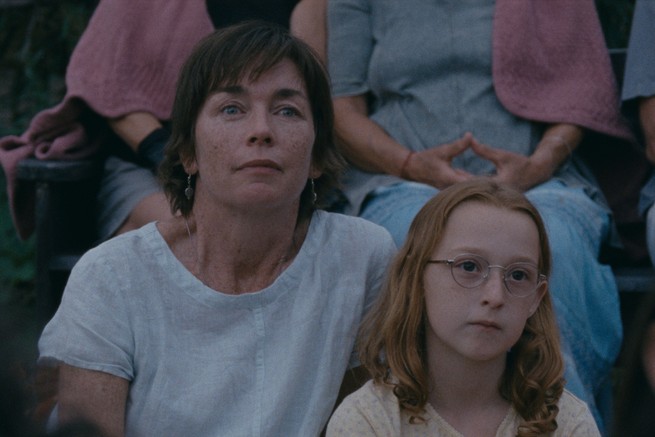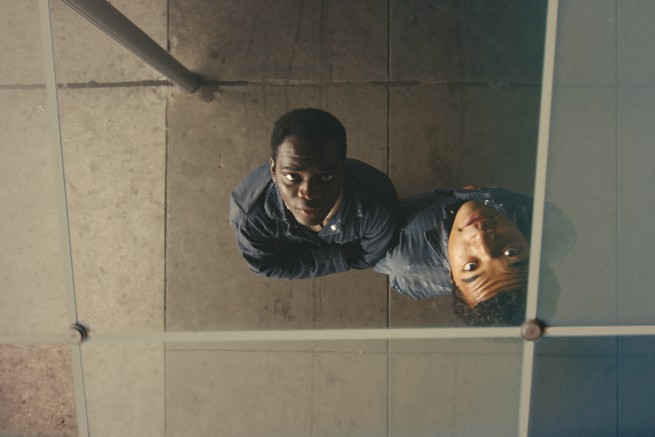The 10 Best Movies of 2024
7 min read
display: none;
}
div[class*=”EditorsNote_content__”]:before {
content: “”;
background-image: url(“https://cdn.theatlantic.com/media/files/bestof2024.png”);
background-size: cover;
width: 120px;
height: 77px;
float: left;
top: -27px;
position: relative;
margin-right: 2rem;
margin-left: 0;
display: block;
}
Every post-pandemic year has been one of commercial frustration and artistic anxiety for the movies. The theatrical experience feels under constant threat; each new generation is supposedly more distracted than the last, unable to lock in for two hours without opening their phones. Undercooked cinematic universes, repetitive sequels, Hollywood strikes, and theater closings have all contributed to a sense that movies must continually justify their existence, more than a century into the medium’s existence.
This year has certainly been an odd one, particularly from a commercial perspective. Hollywood seems to be shifting away from the superhero industry, following decades of reliable box-office domination, but the next trend has not yet emerged. I’m heartened, though, by the broad swath of genres and storytelling approaches of my favorite movies this year, made by a mix of rising filmmakers and established figures. And plenty more titles are worth acknowledging: Jeremy Saulnier’s taut action movie Rebel Ridge; Halina Reijn’s Babygirl, a sly update of the erotic thriller; George Miller’s Dickensian Mad Max spin-off Furiosa; impressive debut features such as India Donaldson’s Good One, Julio Torres’s Problemista, and Arkasha Stevenson’s The First Omen. But my 10 favorites of 2024 were these.

10. Evil Does Not Exist (directed by Ryusuke Hamaguchi)
The Japanese filmmaker’s follow-up to his Oscar-winning breakout, Drive My Car, is deceptively slight at first, depicting a series of dry community meetings where a mountain town’s residents object to the creation of a luxury camping ground. But Hamaguchi is a master of the slow narrative burn, and the minor municipal drama of Evil Does Not Exist eventually reflects the discomfort of a society that feels out of balance, thanks to humanity’s encroachment on the natural world. Few filmmakers can make extended scenes of folks chopping firewood vibrate with tension, but that’s where Hamaguchi’s eye for the smallest behavioral tics—and how they communicate a deeper unease—resonates the most.

9. Trap (directed by M. Night Shyamalan)
Since transitioning back to mid-budget movies with a hooky plot concept (beach that makes you old, cabin at the end of the world), Shyamalan has rediscovered the shock-and-shlock Hollywood alchemy that made him famous. Trap has a Hitchcockian setup, in which a serial killer (the wonderfully nervy Josh Hartnett) brings his daughter to a pop concert and then must escape a battalion of police who are after him, without giving away his secret. Like many of Shyamalan’s best works (The Village, Old), it’s really a devilish tale about parenting, exploring the struggles of work-life balance in the most demented way imaginable.

8. The Brutalist (directed by Brady Corbet)
In today’s risk-free Hollywood, wild ambition ought to be rewarded—whether it’s Shyamalan’s high-end genre fun, or Corbet’s big, honking Great American Novel of a movie, whose monumental highs do more than enough to obscure some glaring flaws. TheBrutalist is a sprawling story about a Hungarian architect (a mesmerizing Adrien Brody) who struggles, then flourishes, then struggles again in postwar America. Over three and a half hours, the movie ponders grand questions of creativity, capitalism, and the evolution of Jewish identity in the aftermath of the Holocaust. Corbet’s prior films have tackled similarly overwhelming themes with more scattershot results, but The Brutalist is a major step up for him as a directorial voice.

7. Anora (directed by Sean Baker)
As Baker has emerged as a significant indie filmmaker over the past decade, much attention has been lavished on his use of nonprofessional actors, real locations, and mobile cameras in films such as Tangerine and The Florida Project. Anora, which won the top prize at this year’s Cannes Film Festival, has the kinetic, shaggy energy of those works. But it also emphasizes Baker’s subversive understanding of classic movie storytelling, updating the screwball comedy of the 1930s for the foul-mouthed, internet-poisoned 2020s. Anora’s swooning first act, in which a sex worker named Ani (Mikey Madison) is swept up by the moronic spawn of a Russian oligarch, is a seductive thrill, and the subsequent acts—in which their romance goes disastrously off the rails, and gaudy high society crashes gleefully into scummy Brighton Beach nightlife—are far better.

6. I Saw the TV Glow (directed by Jane Schoenbrun)
A loopy mix of horror, identity crises, and brain-melting surrealism, I Saw the TV Glow is a definitive text on the long tail of Millennial pop culture. This grander follow-up to Schoenbrun’s impressive debut, We’re All Going to the World’s Fair, plays like a faded memory of a cult TV show. The film homes in on two friends’ warped relationship to a Buffy the Vampire Slayer–esque program that starts to bleed into their own lived experience. It’s an arresting tale of obsession about a particular generation’s proclivity for attaching outsized emotional weight to cultural ephemera—but it’s told with bittersweet understanding, rather than as a scolding fable.

5. Dune: Part Two (directed by Denis Villeneuve)
Every other week, theaters are flooded with blockbusters aiming for the most epic scale possible, filling out their wide screens with CGI goop and all-star cameos as the unending “cinematic universe” arms race continues. It’s worthwhile, then, to acknowledge when something truly gigantic comes out, and the hefty second installment of Villeneuve’s adaptation of Frank Herbert’s beloved sci-fi best seller was exactly that. Sure, it made enough money that we’ll probably see more Dunes in the future; HBO’s spin-off show is already airing. But Part Two told the story of Paul Atreides’s rise to power with a satisfying mix of triumph and gruesomeness, rendering his planetary jihad in awe-inspiring fashion. Villeneuve also pulled it off without losing sight of Herbert’s deeper concerns, like how the hero’s journey often ends in a dictatorial cult of personality.

4. Janet Planet (directed by Annie Baker)
The year’s most impressive filmmaking debut was the playwright Annie Baker’s soft but spiky recollection of life in western Massachusetts in the early ’90s. As a dramatist, Baker has long excelled at conveying complex emotion with something as simple as a pause, and the silences of Janet Planet are just as powerful on the big screen. The sense of atmosphere she summons is even more potent, and the rural environment where mom Janet (Julianne Nicholson) and her listless daughter, Lacy (Zoe Ziegler), live hums with both charm and menace. As Janet navigates various interpersonal relationships without trying to totally alienate her kid, Janet Planet is sweet, sad, and tender to the point of feeling occasionally painful.

3. Challengers (directed by Luca Guadagnino)
Guadagnino hasn’t been afraid of taking on difficult tasks, such as remaking a horror masterpiece (Suspiria) and adapting a swoony love story about cannibals (Bones and All). But with Challengers, he’s done something even more difficult: made a movie that is fun. Not fun like a piece of prescribed corporate pap, but entertaining and messy and out of control—a drama about three tennis players who are always on the cusp of kissing or fighting each other. Challengers is the best kind of froth: well acted, technically impressive, and unafraid to throw a few haymakers at the typical sports movie’s presentation of alpha masculinity.

2. Hard Truths (directed by Mike Leigh)
The first film in six years from Britain’s best living director, Hard Truths is intimate and incremental, telling the story of a character’s slow journey to a revelation about herself—maybe not a breakthrough, but the first cracks of awareness. It starts out as an acidic black comedy of sorts, following the irrepressibly grumpy Londoner Pansy Deacon (an astonishing Marianne Jean-Baptiste) while she cuts a miserable swath through every family member and stranger who crosses her path. As the film progresses, it chips away ever so carefully at what underpins Pansy’s behavior, telling a story about family trauma, mental illness, and post-COVID life without ever feeling like a lecture, a specialty of Leigh’s.

1. Nickel Boys (directed by RaMell Ross)
This adaptation of Colson Whitehead’s novel might sound exhausting: The movie is told entirely in the first person—as in, literal point-of-view shots from the perspective of its main characters, rooting the viewer entirely in their subjective experiences at an abusive reform school in 1960s Florida. The approach, which Ross has used as a documentary filmmaker, shouldn’t make sense for a fiction project—but the result is an audacious reinvention of form. If cinema is an empathy machine, then Nickel Boys’ unique perspective is one of the most exciting attempts in recent history to piece together fragments of memories and feelings for the viewer. Ross’s film depicts moments of deep sorrow and overwhelming love, but the quietest moments—a cake being sliced, a hug haltingly delivered—linger longest in the brain.



